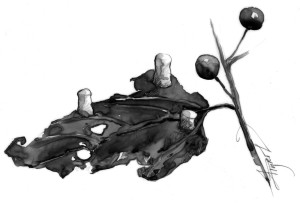
A student plopped a leaf on my desk, pointed to several green lumps on its underside, and asked, “What are those green growths?” It was a stump-the-professor moment, and in this case, I was indeed stumped. The growths certainly seemed to be galls of some sort. But which ones?
Galls are abnormal growths on plants caused by some irritation – often related to an insect. A good first step to identifying a gall is to figure out what plant it came from. Gall-forming insects are very faithful to their host plant species. Specialization makes sense because there’s so much complex chemistry involved in defeating a particular host’s defenses and in coopting its growth mechanisms so that the plant develops the perfect structure to house and feed growing insect larva.
The galls in the leaf on my desk were about the size and shape of a pencil eraser. They protruded from the underside of a common hackberry leaf and were distinctly green, in sharp contrast to the browning fall leaf.
These clues revealed the growths to be hackberry nipple galls (Pachypsylla celtidismamma), which are formed on the undersides of developing hackberry leaves in spring, when insect nymphs in the psyllid family (also called jumping plant lice) release chemicals that redirect normal leaf growth to make a personal green miniature yurt. The interior of the very tiny house provides all of the nutritional needs of the single pale yellow nymph growing inside. The nymphs grow through summer, and in early September cut exit holes in their galls and drop to the ground.
After a final molt, the brand-new adults look for places to hibernate. The rough bark of hackberry provides plenty of nooks and crannies for the tiny adults. Despite the abundance of seemingly perfect overwintering homes for these tiny insects, however, many still make their way into our houses. These very tiny, jumping, cicada-like insects are harmless to pets and people, so their appearance indoors is a minor inconvenience likely to be experienced by anyone with hackberry trees growing close to their home.
Hackberry trees offer many benefits to birds and other wildlife. The nutritious berries provide a balanced diet of proteins, fats, and carbohydrates. In return, the seeds get dispersed far and wide in the droppings of the animals that eat them. Hackberries also host more than 30 species of butterfly and moth larvae, including the hackberry emperor, which is found only on hackberries.
In addition to the Hackberry nipple gall makers, four other gall-forming psyllid species specialize on hackberries. Three of these species emerge in early fall and are important food sources for migrating birds. The fourth species overwinters in its galls and emerges in early summer.
All of these diverse insects attracted to one tree species begs the question, how do the trees survive the onslaught? Hackberries have coevolved with a broad array of native invertebrates and seem well adapted to dealing with the challenge. It is not uncommon for a few hackberry branches to be affected by galls while the rest of the tree remains largely unscathed, and there does not seem to be much, if any, damage to the overall health of the trees.
Saint Michael’s College was lucky to be gifted more than 30 hackberry trees by the Arbor Day Foundation this year. More than 20 students and staff members spent a fall afternoon planting them in the college’s Natural Area. Maybe, in 30 years or so, a future student will stump a different professor with a leaf bejeweled with little green yurts!


Discussion *